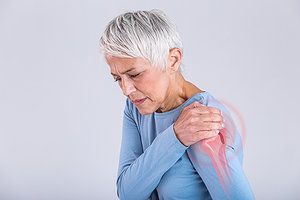You became a chiropractor to serve people, not an insurance company. You deserve to run a business that aligns with your values, supports your family and lights you up. Cash-based care isn’t just a pricing model – it’s a philosophy rooted in freedom, trust and respect for your patients and for yourself. Here's why - and how - to do it.
Shoulder Pain Leads to Myositis Diagnosis: What to Watch For
At the end of last year, a 63-year-old female patient was referred by her primary care provider to chiropractic within a Federally Qualified Health Center in St. Louis, Mo., for evaluation and management of her shoulder pain.
History and Examination
The patient's pain had gotten increasingly worse over the past few months, and she now had difficulty with daily tasks like reaching into cabinets and lifting objects overhead. There was no injury or trauma to the shoulder, so the patient simply attributed the pain to the general aches of aging.
In addition to her shoulder pain, the patient noted walking with a cane and having some weakness in her legs. She had trouble with prolonged standing, and found it difficult to sit down in and stand up from a chair. Health history was notable for congestive heart failure with lower-extremity edema, hypertension, prolonged statin use, type 2 diabetes, and asthma.

During chiropractic examination, there was notable weakness bilaterally in the patient's arms and legs, with reduced muscle bulk and tone of the upper extremity. This raised concern for a primary muscle disease, and bloodwork was ordered including muscle enzymes.
Laboratory investigation revealed elevated aldolase (67.7 U/L; normal <8.1) and creatine kinase (12319 U/L; normal 29-143). This confirmed the suspicion of a myopathy, and the patient was referred to a local hospital for further evaluation and management.
Features of Myopathies
Myopathies are neuromuscular disorders which may attribute to problems with voluntary movement, muscle weakness and stiffness. Myositis is a subtype of myopathy that causes inflammation in muscles.
Highly elevated levels of creatine kinase are commonly evaluated for idiopathic inflammatory myopathies. Creatine kinase and other cytosolic enzymes leak from the sarcoplasmic membrane when the muscle is damaged or inflamed.
Common features of inflammatory myopathies include the following:
- Weakness in the large muscles around the neck, shoulders and hips
- Trouble climbing stairs, getting up from a seat, or reaching for objects overhead
- Little, if any, pain in the muscles
- Choking while eating or aspiration (intake) of food into the lungs
- Shortness of breath and cough
While myopathy is rare and generally not fatal, it's still a serious diagnosis, as it can affect muscles critical to the body's internal function, like the heart and the muscles that control swallowing. Idiopathic inflammatory myopathies can also affect the lungs, joints and skin, which diminishes overall quality of life.
Testing for Myositis
The patient was admitted to the hospital, where she spent 10 days undergoing countless tests and blood draws. The hospital ran all the general tests for myositis:
- Bloodwork to look for markers of muscle breakdown like creatine kinase and aldolase, inflammation, or elevated levels of ESR and CRP
- Electrodiagnostic studies that determine the muscle response to electrical stimulation (e.g., needle EMG)
- Imaging such as MRI to better assess the muscle architecture
- A biopsy, which can sometimes be needed to get a muscle sample to study pathology and determine a diagnosis
While myositis is more common in older adults, younger patients often experience more severe symptoms and have a more serious diagnosis. For this reason, it's important to ensure myositis is not ruled out without proper investigation and testing.
In this case, after further blood tests and electrodiagnostic muscle and nerve studies were complete, a muscle biopsy of the right lateral thigh muscle tissue was ordered. The biopsy came back positive for necrotizing autoimmune myopathy, general muscle inflammation that can be induced by many things including medications, strenuous exercise, some forms of cancer and aging.
"The inflammatory myopathies are a heterogeneous family of diseases characterized by muscle weakness, elevated serum muscle enzyme levels, autoantibodies, and inflammatory muscle biopsies."1
The patient's biopsy with elevated HMG-CoA reductase (HMGCR) antibodies showed features of necrotizing autoimmune myopathy with histiocytic and focal lymphocytic inflammation. There was evidence of necrotic muscle fibers and macrophage infiltrates on the pathology tissue report.
The Cause: Statin Use
It was discovered that the patient's myositis was caused by a statin, a medication she was taking to keep her cholesterol low.
"As a conservative estimate, at least 1.5 million people per year will experience a muscle related adverse event while taking a statin. Symptoms of statin induced myopathy include fatigue, muscle pain, muscle tenderness, muscle weakness, nocturnal cramping, and tendon pain. The muscle symptoms tend to be proximal, generalized, and worse with exercise."2
Practical Takeaways
While this patient is not quite back to full function, as her recovery is ongoing, she did quickly begin to feel better with the discontinuation of the offending medication. The patient is now on medication to help with the inflammation of her muscles and is participating in continuous rehabilitation.
Chronic autoimmune diseases can greatly impact a person's quality of life; therefore, proper co-management and accurate resources are necessary to ensure the patient receives proper care.
Myopathies are a heterogenous group of disorders with ranging etiologies and diverse pathophysiology.3 Myositis is rare, but it's important for chiropractic physicians to be well-versed in the disease to better care for their patients.
It is crucial as chiropractic physicians to differentiate true muscle weakness from fatigue, frailty or pain-related motor impairment with no abnormal objective strength testing. Proper diagnosis is made with careful consideration of history and clinical features, diagnostic criteria, blood testing, and results from an MRI and muscle biopsy.
Authors' Note: Written informed consent was obtained from the patient to publish her de-identified information.
References
- inal-Fernandez I, Casal-Dominguez M, Mammen AL. Immune-mediated necrotizing myopathy. Curr Rheum Rep, 2018;20(4):21.
- Sathasivam, S, Lecky, B 2008. Statin induced myopathy. BMJ, 2008;337:a2286.
- Larson ST, Wilbur J. Muscle weakness in adults: evaluation and differential diagnosis. Am Fam Physician, 2020 Jan 15;101(2):95-108.



